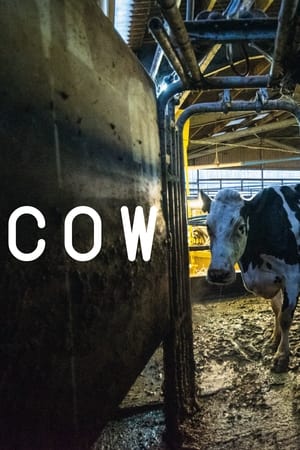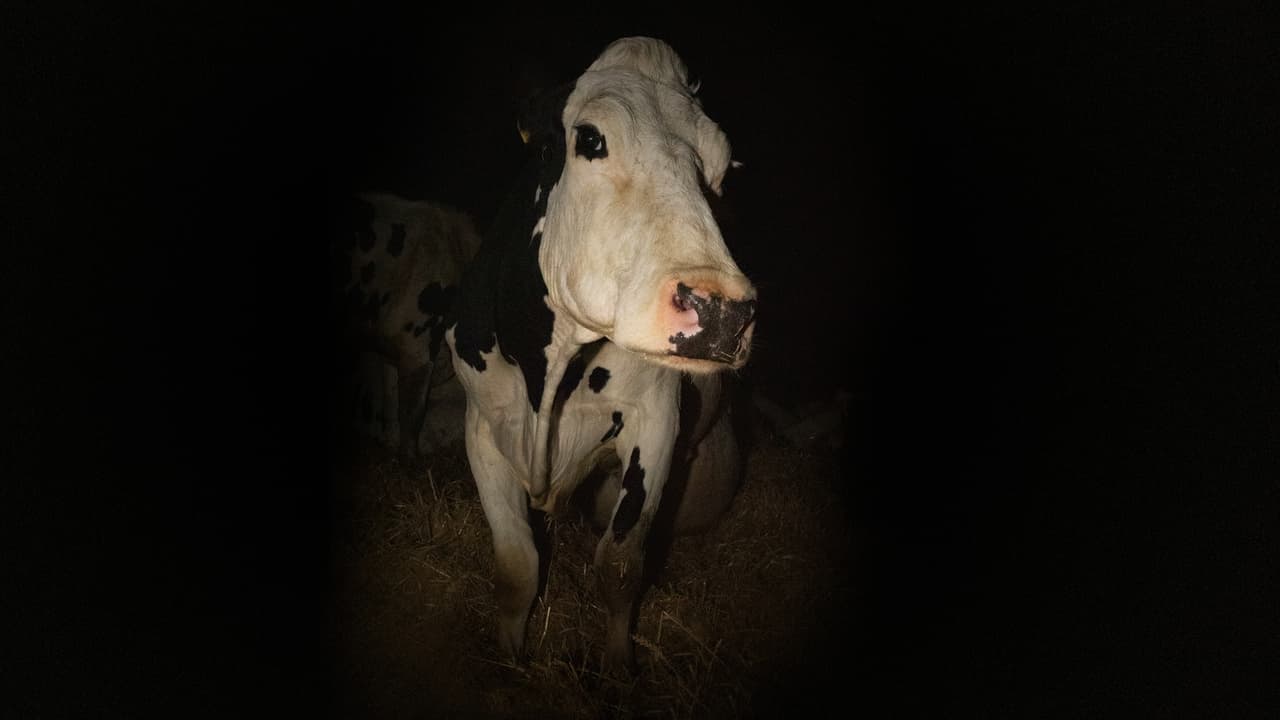
Throughout her career, Andrea Arnold has told stories about women in constrictive circumstances who seek liberation via danger, whether that takes the form of stalking someone via CCTV monitors (Red Road), getting involved with a much older man (Fish Tank), or living in a van alongside Shia LaBeouf (American Honey). The subject of Arnold’s latest film is likewise female; in this case, however, the danger has come to her. Indeed, one could argue that what we have here is a heavily condensed version of The Handmaid’s Tale, portraying a society in which possessing a uterus means being held captive for your entire life, forced to churn out offspring for the ruling class, forever giving birth only to have the baby—and even the milk that your body produces for it—instantly stolen. For Cow is Arnold’s first documentary, shot over four years on an English dairy farm and focusing on a single animal whose very existence depends upon her utility to human beings. Her name, it’s eventually just possible to discern from background chatter, is Luma, but the film has been aptly titled: In the end, she is simply Cow.
That synopsis, while accurate, makes Cow sound significantly more didactic than it actually is. Far from a PETA screed that seeks to expose the cruelty of factory farming, this scrupulously observational doc presents what seems like a dairy cow’s best-case scenario: The animals are treated humanely (within the bounds of their function as producers of calves and milk), as far as we can see, and get opportunities to roam freely outdoors; there doesn’t even appear to be a nearby road that subjects them to the indignity of being loudly mooed at by kids in passing cars. In a way, that makes things more difficult for those of us who might be described as ambivalent omnivores. If a farm egregiously mistreats animals, one can try to put a stop to it, imagining that success will mean a better (or at least less painful) life for the poor creatures. Cow depicts that ostensibly better life in considerable uninflected detail, and many viewers will still wind up thinking twice about pouring some 2% over their next bowl of cereal.
Arnold has two things working against her with this project, one of which was beyond her control. She couldn’t have foreseen that Cow’s thunder would be stolen to some degree by Gunda, a conceptually similar documentary that includes a lengthy segment devoted to cows (though Gunda’s maternal anguish involves its titular pig). Anyone who saw that movie will likely find this one at least a little redundant. The bigger problem, though, is that Cow tells a reasonably knowledgeable viewer nothing that they didn’t already know. Maybe there are still a few people out there who hear “dairy cow” and picture a milkmaid on a stool, but I’d wager that most of us have at some point learned the less pastoral truth and will grimly nod at this film’s many shots of Luma and company packed into stalls with high-intensity nozzles attached to their udders, mechanically pumping away. Once you know what Cow entails, there’s little need to actually watch it, unless you really want to get attached to a doomed animal. (Warning to the sensitive and/or squeamish: While there's no slaughterhouse here, the film has a brusquely unhappy ending.)
Even an emotional attachment’s uncertain, frankly. Arnold’s approach here is the one that I generally prefer in documentaries: Context-free, devoid of interviews, simply training the camera on events as they unfold. It admittedly has some drawbacks, as my alarmed browser history will attest: Googling “holes burned in cow’s head” revealed a commonplace process called debudding, meant to kill the cells that would develop horns. (We actually see Luma’s calf receive local anesthetic beforehand, but I failed to make the connection.) Still, I’d rather be left curious than spoon-fed, as a rule. In this case, though, what the camera captures conforms so precisely to what you’d anticipate that the fly-on-the-wall method—or flies-in-the-eyes, when the cows are outdoors—proves overly banal. Arnold presumably didn’t want to aestheticize Luma’s day-to-day grind, instructing cinematographer Magda Kowalczyk to shoot close and handheld and unglamorous; the result is pretty much just “life of a dairy cow,” absent much visual interest. (If you’d like to see what grandeur can be achieved with just some cows, a child, and the gradually setting sun, watch the astonishing opening sequence of Carlos Reygadas’ Post Tenebras Lux.) Nor does Luma really develop what you’d call a distinct personality, even if she occasionally head-butts the camera in irritation. Mostly, we just look at her and anthropomorphize away, projecting what we’d feel in similar circumstances onto her impassive gaze. It “works,” but only in the most superficial way.
The most interesting choice Arnold makes is to assume a sort of cow’s-eye perspective—not literally (we almost never get an ostensible point-of-view shot), but in the way that Cow makes its farmhands incidental. None of them ever so much as acknowledges the camera, much less speaks to it; at the same time, though, no effort is made to keep human beings mostly offscreen, à la the adult scientists in E.T. They’re seen as a cow might experience them: showing up at random, performing tasks that you don’t necessarily understand, chattering idly amongst themselves. We also hear what’s presumably their music: Several scenes feature the clearly diegetic sound of pop songs booming through the cowshed, allowing us to wonder what Luma makes of, say, Kali Uchis’ “Tyrant” or (it must have been December) the Pogues’ “Fairytale of New York.” Arnold has admitted in interviews that she chose the tunes herself, inspired by what she actually heard at the farm, and there are times when the lyrics, in concert with what’s happening onscreen at that moment, come close to delivering a straightforward message. As the closing credits roll, Arnold truly can’t resist: They’re set to the final track on Garbage’s 1995 debut album, which begins “I am milk.”
One of the first notable online film critics, having launched his site The Man Who Viewed Too Much in 1995, Mike D’Angelo has also written professionally for Entertainment Weekly, Time Out New York, The Village Voice, Esquire, Las Vegas Weekly, and The A.V. Club, among other publications. He’s been a member of the New York Film Critics Circle and currently blathers opinions almost daily on Patreon.
That synopsis, while accurate, makes Cow sound significantly more didactic than it actually is. Far from a PETA screed that seeks to expose the cruelty of factory farming, this scrupulously observational doc presents what seems like a dairy cow’s best-case scenario: The animals are treated humanely (within the bounds of their function as producers of calves and milk), as far as we can see, and get opportunities to roam freely outdoors; there doesn’t even appear to be a nearby road that subjects them to the indignity of being loudly mooed at by kids in passing cars. In a way, that makes things more difficult for those of us who might be described as ambivalent omnivores. If a farm egregiously mistreats animals, one can try to put a stop to it, imagining that success will mean a better (or at least less painful) life for the poor creatures. Cow depicts that ostensibly better life in considerable uninflected detail, and many viewers will still wind up thinking twice about pouring some 2% over their next bowl of cereal.
Arnold has two things working against her with this project, one of which was beyond her control. She couldn’t have foreseen that Cow’s thunder would be stolen to some degree by Gunda, a conceptually similar documentary that includes a lengthy segment devoted to cows (though Gunda’s maternal anguish involves its titular pig). Anyone who saw that movie will likely find this one at least a little redundant. The bigger problem, though, is that Cow tells a reasonably knowledgeable viewer nothing that they didn’t already know. Maybe there are still a few people out there who hear “dairy cow” and picture a milkmaid on a stool, but I’d wager that most of us have at some point learned the less pastoral truth and will grimly nod at this film’s many shots of Luma and company packed into stalls with high-intensity nozzles attached to their udders, mechanically pumping away. Once you know what Cow entails, there’s little need to actually watch it, unless you really want to get attached to a doomed animal. (Warning to the sensitive and/or squeamish: While there's no slaughterhouse here, the film has a brusquely unhappy ending.)
Even an emotional attachment’s uncertain, frankly. Arnold’s approach here is the one that I generally prefer in documentaries: Context-free, devoid of interviews, simply training the camera on events as they unfold. It admittedly has some drawbacks, as my alarmed browser history will attest: Googling “holes burned in cow’s head” revealed a commonplace process called debudding, meant to kill the cells that would develop horns. (We actually see Luma’s calf receive local anesthetic beforehand, but I failed to make the connection.) Still, I’d rather be left curious than spoon-fed, as a rule. In this case, though, what the camera captures conforms so precisely to what you’d anticipate that the fly-on-the-wall method—or flies-in-the-eyes, when the cows are outdoors—proves overly banal. Arnold presumably didn’t want to aestheticize Luma’s day-to-day grind, instructing cinematographer Magda Kowalczyk to shoot close and handheld and unglamorous; the result is pretty much just “life of a dairy cow,” absent much visual interest. (If you’d like to see what grandeur can be achieved with just some cows, a child, and the gradually setting sun, watch the astonishing opening sequence of Carlos Reygadas’ Post Tenebras Lux.) Nor does Luma really develop what you’d call a distinct personality, even if she occasionally head-butts the camera in irritation. Mostly, we just look at her and anthropomorphize away, projecting what we’d feel in similar circumstances onto her impassive gaze. It “works,” but only in the most superficial way.
The most interesting choice Arnold makes is to assume a sort of cow’s-eye perspective—not literally (we almost never get an ostensible point-of-view shot), but in the way that Cow makes its farmhands incidental. None of them ever so much as acknowledges the camera, much less speaks to it; at the same time, though, no effort is made to keep human beings mostly offscreen, à la the adult scientists in E.T. They’re seen as a cow might experience them: showing up at random, performing tasks that you don’t necessarily understand, chattering idly amongst themselves. We also hear what’s presumably their music: Several scenes feature the clearly diegetic sound of pop songs booming through the cowshed, allowing us to wonder what Luma makes of, say, Kali Uchis’ “Tyrant” or (it must have been December) the Pogues’ “Fairytale of New York.” Arnold has admitted in interviews that she chose the tunes herself, inspired by what she actually heard at the farm, and there are times when the lyrics, in concert with what’s happening onscreen at that moment, come close to delivering a straightforward message. As the closing credits roll, Arnold truly can’t resist: They’re set to the final track on Garbage’s 1995 debut album, which begins “I am milk.”
One of the first notable online film critics, having launched his site The Man Who Viewed Too Much in 1995, Mike D’Angelo has also written professionally for Entertainment Weekly, Time Out New York, The Village Voice, Esquire, Las Vegas Weekly, and The A.V. Club, among other publications. He’s been a member of the New York Film Critics Circle and currently blathers opinions almost daily on Patreon.






